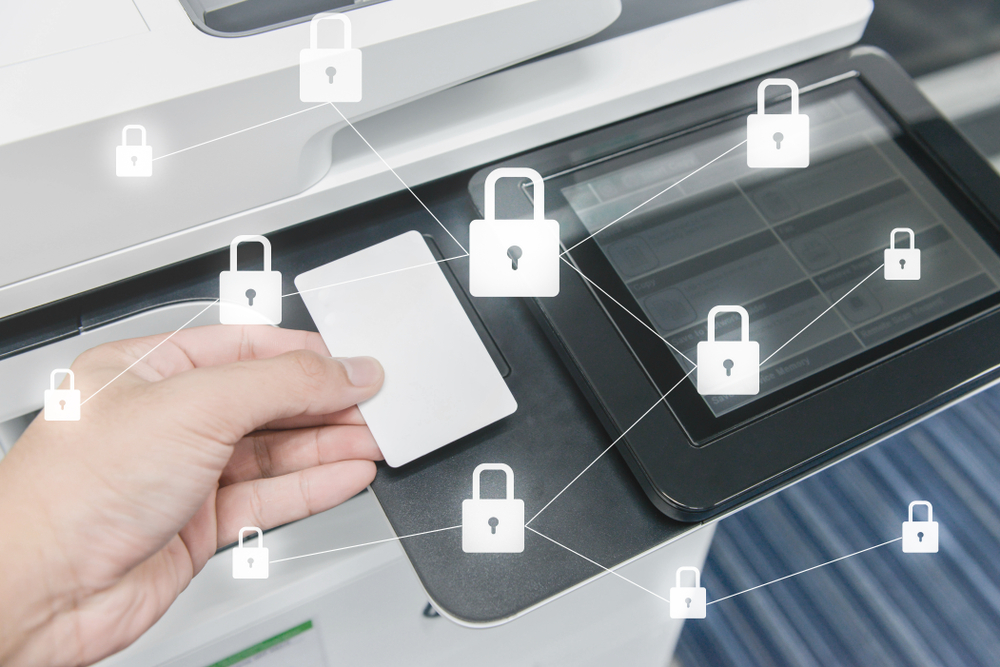The hybrid work environment has expanded the exploitable attack surface, and multiple layers of security are required to protect it from external and internal threats. Implementing secure print solutions is an easy way to ensure neither network data nor printed documents fall into the wrong hands. RFID readers and mobile authentication technology solutions help organisations implement secure print policies and seamlessly enable user authentication across multiple identification platforms.
The expanded threat landscape
Businesses of all sizes are facing a rising tsunami of cybersecurity risks. In today’s cloud- and AI-driven hybrid work era, the threat landscape is complex and constantly evolving, with new, more sophisticated cyber threats emerging daily – whether these involve malware, phishing, or ransomware attacks. Meanwhile, security teams are dealing with a whole new raft of security threats, misconfigured access points, weak passwords, lack of identity and access management (IAM), and failure to use multi-factor authentication.
Quocirca’s Global Print Security Landscape 2023 report reveals that the volume of overall security incidents has increased in the past year for 61% of organisations, rising to 70% in the US and 66% in business and professional services organisations. Yet, just 38% of organisations use a secure print solution (such as pull-printing) to ensure documents are only released to authorised users.
The impact of a data breach can be severe, if not catastrophic. With end points representing the most common attack vector and cyber-attacks continuing to grow in sophistication, organisations are finding it harder to detect and defend against cybersecurity threats. Meanwhile, the most common threat is from insiders – with the majority of data breaches caused by human error.
Print security is non-negotiable
Today’s smart MFPs have several points of vulnerability – in addition to the printed output that can fall into the wrong hands without the right controls, devices can be attacked and become access points to the wider network.
However, for many organisations, securing a diverse printer fleet that may include multiple brands, legacy devices, and a patchwork of software and drivers can be challenging. The risk is exacerbated in today’s distributed hybrid work environments, where MFPs are shared among more users, sometimes in settings that involve more than one company or are away from standard controllable locations, such as in an employee’s home.
Meanwhile, a multi-vendor environment may not incorporate consistent security controls, and a fragmented approach to cloud printing may create further security risks around access and authentication. Similarly, organisations may already have access token systems in place and be unwilling to burden employees with additional cards.
Home printers, particularly those that were purchased by employees, may not meet corporate security standards or be monitored through centralised security tools. Remote workers may be accessing data from unsecured home or public Wi-Fi networks.
Yet, print security remains low on the agenda compared to top priorities such as cloud and email. This lack of priority – or complacency – is leaving businesses vulnerable given that paper is one of the least secure mediums in the workplace. While device attacks are rare, the likelihood of paper documents being accessed by unauthorised recipients is increasingly prevalent. Quocirca’s research revealed that, on average, 27% of IT security incidents relate to paper documents, and overall, 61% of organisations have experienced a paper-related data breach. This has led to an average print data breach cost of $970,000 – the financial consequences of a data breach can be severe for businesses of any size.
The complexity of securing the print infrastructure is putting more pressure on already-stretched IT teams. According to Quocirca’s research, 39% of IT decision-makers believe print security has become harder to manage.
It is, therefore, perhaps unsurprising that just 19% of ITDMs are completely confident that their print infrastructure is protected from security breaches and data losses. This drops to just 11% among SMBs.
Mitigating the risk with multi-layered print security
Fortunately, these risks can be mitigated in simple and effective ways. Secure printing is a key element of a broader multi-layered, integrated approach to print security. Quocirca’s Print Security Maturity Index reveals that organisations classed as security leaders (defined as those that have implemented a range of measures, including security assessments, pull-printing, and formal print security policies) are seeing lower levels of data loss and have higher confidence in the security of their print infrastructure.
Advanced secure printing solutions ensure that documents are only released to authorised users, when the user authenticates at the device via RFID card, smartphone mobile credentials, or biometrics. This allows organisations to ensure employees have a consistent way of releasing documents across distributed environments and overcome some of the inherent risks associated with using basic PINs or weak password credentials alone.
With just 38% of organisations reporting that they have implemented secure printing, advanced secure printing solutions based on RFID technology offer a clear opportunity to mitigate the growing risk of print-related data breaches.
Security and convenience with ELATEC RFID readers
ELATEC, a global provider of universal RFID, NFC, and Bluetooth® Low Energy (BLE) readers, is well established in the print security market. Its RFID readers offer convenient user authentication and access control across a wide range of locations, equipment, and systems. The readers integrate with leading MFP brands and print software, allowing employees to authenticate at devices with the same RFID cards they use to enter the building, which eliminates the need for new systems. This overcomes the risks associated with using passwords or PINs to release print jobs. The card can also be implemented as part of many existing smartphone apps.
With RFID card and smartphone credentialing systems, users simply wave their ID card or smartphone over the reader to release the print job. The reader connects with the print management software system to authenticate and match the user with the print jobs they sent. All of this is recorded in case a forensic investigation around information loss is required. Usage and volume of consumables used can also be monitored and tracked for chargeback purposes.
Such an identity management platform is extensible. For example, ELATEC supports mobile credentials and access solutions that can be integrated into existing secure identity systems. Examples include building information management (BIM) systems, for unlocking doors or clocking into a building, as well as single sign-on (SSO) systems for logging onto a computer network or accessing applications. The solutions leverage standard device technologies and are universally accessible, easy to deploy, and simple to manage.
Further security capabilities involve the location of the user and printer. For example, if a user is logged as being in one part of a building and trying to free up a print job in another, the system can flag this as a likely problem and put a hold on the print job until the issue between location and action can be resolved. Different security approaches can be applied based on location – for example, an employee may be able to print a document while in the office, but not when at home or in a public environment. Certain documents may only be printable in a secure print room, which enables much greater control over what information is made available, even within the organisation.
As such, an RFID approach can enable a well-rounded security strategy, blending in location, time, user credentials, application access, and information type, while bringing together all aspects of security that an organisation needs – not just at a simplistic IT level. For example, even if a malicious actor gains entry to an IT environment, using RFID tokens integrated into SSO systems and protecting information flows and print job processes prevent them from accessing important information.
As an extra layer of security, the RFID signal can be encrypted, making the solution much more secure than a password or PIN system. The transponder signal cannot be easily cloned or hacked, and employees are much less likely to share their corporate ID card or phone than a printer password or PIN. Even when a card is mislaid or stolen, it can be easily deleted from the access database, and the physical card will be inactive.
The path forward
The threat landscape is set to become more complex, with advanced cyber-attacks likely to result in far-reaching financial and business impact. Therefore, ensuring resilient and secure print infrastructure as part of the overall IT and business information environment, while supporting efficiency, is a business imperative.
Printing remains a key element of the IT infrastructure, and organisations must treat print security as any other end point on the network. RFID access control and mobile authentication will enable IT teams to balance security with productivity in today’s evolving hybrid workplace.
To find out more, download a complimentary report, sponsored by Elatec.





